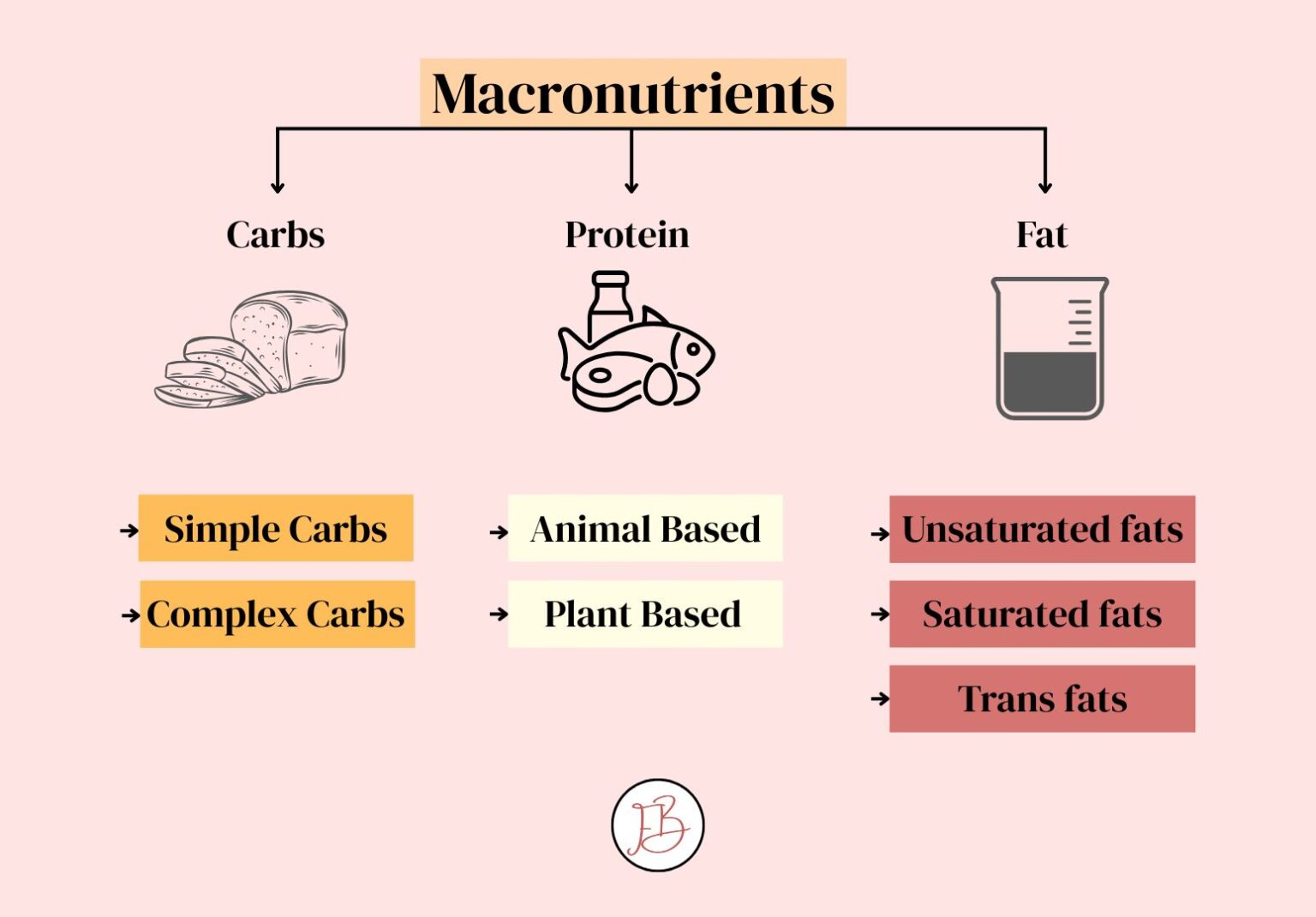Introduction

Ever wonder what people mean when they talk about “macros” in their diet? In the world of dieting and nutrition, counting macros has become increasingly popular. Here you will know about macronutrients and there types, and managing macros, Are macros the same as calories?
What Are Macronutrients?
Macronutrients are often just called as “macros”. Macronutrients are the nutrients your body needs in large amounts to function. Macronutrients include three main types of macros are carbohydrates, proteins, and fats.
Each one plays a unique role in how your body works, and no, you don’t need to cut any of them out completely. On the other side you also need vitamins and minerals in smaller quantities these are called as micronutrients.
- Carbohydrates
Carbs tend to get a bad rap these days but, In fact, carbs are the main source of energy. Carbohydrates are found in bread, rice, pasta, fruits, veggies, and even dairy. (1) Carbohydrates are composed of sugar, starch, and fiber and are the body’s primary source of energy.
The sugars found in carbohydrates are broken down into glucose by the body through the process of digestion, which is either used immediately for energy or stored as glycogen to be used later on, between meals or during exercise.
Now, not all carbs are created equal. You’ve got two main types:
- Simple carbs: These are found in things like candy, soda, and white bread. They give you quick bursts of energy, but that energy doesn’t last long.
- Complex carbs: You’ll find these in whole grains, beans, veggies, and fruits. They take longer to digest, which means steady energy without the crash.
- Protein
If carbs are your energy source, protein is your body’s repair crew. (2) Proteins are made from compounds called amino acids, which are the building blocks for many structures and functions in the body. It is also involved in everything from repairing tissues to making enzymes and hormones.
You can get protein from both animal and plant-based sources:
- Animal-based: chicken, beef, fish, eggs, dairy.
- Plant-based: beans, lentils, tofu, quinoa, nuts, seeds.
- Fats
Fats are made up of smaller molecules called fatty acids, which are composed of carbon and hydrogen elements joined together in long chains called hydrocarbons. Fats are found in saturated and unsaturated forms and, depending on their exact structure, can be used as a source of energy.
They help your body absorb vitamins (like A, D, E, and K), support brain health, protect your organs, and even help regulate hormones.
There are a few types of fats to know:
- Unsaturated fats: These are the healthy ones, found in foods like avocados, olive oil, nuts, seeds, and fatty fish like salmon. They’re good for your heart and your brain.
- Saturated fats: Found in things like butter, cheese, red meat, and coconut oil. A little is okay, but too much can raise cholesterol levels.
- Trans fats: These are the ones to watch out for. They’re often found in processed or fried foods and can mess with your heart health. Best to avoid when you can.

Water: The Forgotten Macronutrient
Your body needs water in large amounts every single day just like carbs, protein, and fat. Your body is made up of mostly water. It helps regulate your temperature, keeps your joints cushioned, aids in digestion, and even helps move nutrients around where they’re needed.
You don’t need to overthink it. Just try sipping water throughout the day, especially when you’re active, it’s hot out, or you’re feeling sluggish. And yes, other drinks and water-rich foods like fruits and veggies count toward your hydration, too.
Macronutrient Balance: Why It Matters
Think of your macros like a team. Carbs, protein, and fat all have different roles, but they work best when they’re playing together. If one is way out like eating more of carbs but barely any protein or fat you might feel tired, hungry all the time, or just not like yourself.
The right balance really depends on you:
- If you’re super active or trying to build muscle, you might need more Protein.
- Training for a marathon? Then Carbs
- Looking to feel fuller longer or support hormone health? Then take Healthy Fats
Are macros the same as calories?

Macros are the building blocks of calories, therefore tracking macros essentially means tracking calories; yet, recording calories does not always imply tracking macros.
Each gram of macronutrient has a certain number of calories. (Carbs – 4 Calories, Protiens – 4 Calories, fats – 9 Calories) by tracking the total number of grams of carbohydrates, proteins, and fats you are consuming you will be tracking your total calorie intake as well.
For example: if your goal is to consume
200 grams of carbohydrate per day, (200×4 = 800)
100 grams of protein per day (100×4 = 400)
50 grams of fat per day (50×9 = 450)
The total no of calories consumed would be 1650 Calories (800+400+450)
- Calories from Carbohydrates = xx of grams x 4 calories per gram
- Calories from Protein = xx of grams x 4 calories per gram3
- Calories from Fat = xx of grams x 9 calories per gram
How to Get Started With Managing Macros
Now let’s talk about managing macros and how to actually use it in your everyday life. Small changes go a long way.
- Start with awareness, not obsession: You don’t have to count every gram of protein or carb unless you want to. Just start paying attention to a mix of protein, fat, and carbs. There are many different ways to determine your calorie needs, a simple online macro calculator is a great place to start.
- Read nutrition labels: Labels can be super helpful in understanding what’s in your food. You’ll start to notice how many foods are carb-heavy or low in protein and that can help you make more balanced choices without overthinking it.
- Track your Macros: In order to ensure accuracy with this method, foods must be weighed, measured, and logged to ensure that you are reaching your carbohydrate, protein, and fat goals. The easiest and most convenient way to track macros is by using an app such as myfitnesspal, cronometer, macrosfirst, loseit. These apps are designed to calculate the macros in the food you consume and are a very user-friendly way to track macros.
Benefits of Counting Macros
- Understand the Value of Portion Size
- Understand the Impact of Macronutrients
- Eat a More Balanced Diet
- Understand Dieting Flexibility
- Holds You Accountable
Drawbacks of Counting Macros
- Does not Ensure Food Quality
- Takes a Lot of Time and Effort
- Can Make Mealtime Stressful
- Not Sustainable for the Long-Term
- Can Promote Disordered Eating
Bottom Line
Macronutrients includes carbs, protein, fat, and water that aren’t just nutrition buzzwords. They’re the core elements your body needs to thrive. You don’t need a complicated plan to eat well with just a little balance, some mindful choices, and an understanding of what fuels you best. When you focus on quality and variety, your body does the rest. Counting macros may be a beneficial short-term tool for some, it is likely not a good fit for everyone nor is it a long-term strategy.



